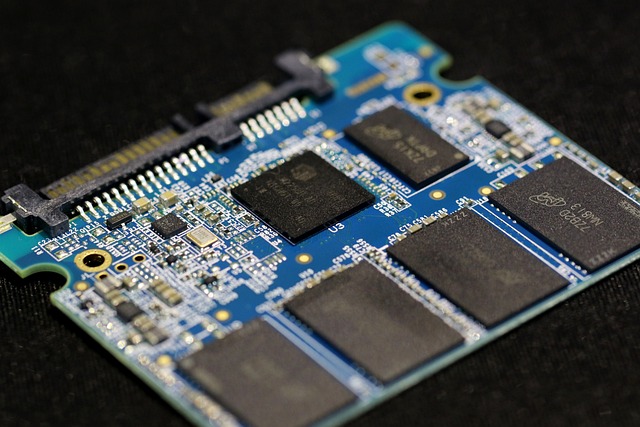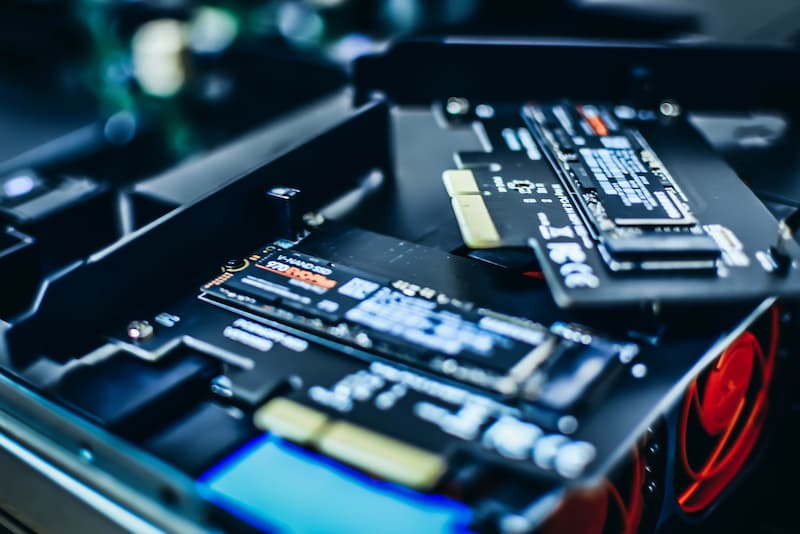
In the battle of NVMe vs. SSD, the former provides a latency-free and high-bandwidth storage experience. It is the most recent and might be the best storage option for a variety of devices, providing faster read and write speeds than more traditional options.
Nevertheless, depending on how you intend to use them, these advantages come at a price. Therefore, in many situations, you must decide whether it is worthwhile to spend more money on an NVMe setup.
In order to help you make an informed choice, we have done extensive web research and sprinkled our personal storage solution experiences throughout this blog.
Table of Contents
What is SSD?
As technology developed, the performance of conventional Hard Disk Drives (HDDs) became constrained. Innovative thinkers immediately got to work and unveiled brand-new, cutting-edge HDD storage solutions. It evolved into the Solid-State Drive (SSD), a storage device that is comparable to its predecessor but significantly more potent.
SSDs use flash memory to store data, with non-volatile NAND storage being the industry standard. However, because SSDs were designed to take the place of HDDs, they transfer data using the same SATA and SAS interface hardware.
Its significant capabilities are limited by a powerful Solid-State Drive and an antiquated interface. The absence of conventional moving parts, such as the spinning disks found in an HDD, such as SSDs is an important distinction to make. An SSD device, however, uses non-moving semiconductor memory chips to access and store data.
What is NVMe?
Solid-state drives have been upgraded to NVMe. It connects directly to the CPU bus on the computer’s motherboard instead of going through the SATA interface, which is the difference. In order to give computers better performance than what SSDs can provide, Samsung introduced this storage technology in 2013.
Non-Volatile Memory Express is the usual abbreviation for this term. The critical factor to note is the “e”, which stands for “express”. PCIe, or Peripheral Component Interconnect Express, is referred to here. Higher data transfer and lower latency rates are ensured by PCIe.
You won’t lose data if there is a power outage because this type of storage is non-volatile. The fact that these cutting-edge SSDs have read and write speeds that average 4000 MB is also very important to note. Compared to a typical SSD, that is 20 times faster.

The Difference Between NVMe and SSD
Recognizing the NVMe vs. Some people find SSD comparison to be confusing, but it’s actually fairly simple. In essence, every NVMe storage device is an SSD device. However, not all SSDs are NVMe drives. To put it another way, an NVMe drive is one type of SSD drive, but there are other kinds as well.
Here are a few noteworthy variations between NVMe and. types of SSD storage memory.
NVMe Vs. SSD Cost
NVMe vs. Cost is typically a key factor to take into account when purchasing SSD. There are few price differences between mid-range PCIe 3.0 SSDs and their SATA counterparts due to the availability of different storage manufacturers.
An NVMe storage will probably cost you $20 more than a SATA SSD. But when you take into account how much more potent and dependable enterprise-grade NVMe devices are, the price goes up exponentially.
These robust devices are ideal for heavy use, as was previously mentioned. For private use, they could be a waste of money. NVMe SSDs are preferable to conventional SSDs if you want faster performance.
NVMe Vs. SSD Input/Output Speeds
The NVMe vs. has what is likely its most notable feature. NVMe drives are essentially much faster than any typical SSD form factor you might have. NVMe solutions are thus the more reliable and cutting-edge choice.
NVMe SSDs record read and write speeds that are on average 4000 MB/s. And for the most sophisticated enterprise NVMe drives, this speed is even higher. The read and write rates, which range from 4 to 7 GB/s, are the cause.
On the other hand, typical SSD drives can reach 400 MB/s in speed. That is roughly a tenfold slower speed than your typical NVMe drive.
NVMe Vs. SSD Physical Appearance
Many people tend to believe NVMe SSDs are only made for M.2 ports when thinking about the different types of SSDs that are available. Likewise, some are under the impression that SATA SSDs are only a 2.5″ storage solution. Since these memory types have similar form factors, that is not the case.
The truth is that you can have NVMe 2.5″ drives and also have However, the physical distinction to be aware of typically lies in the keys for SATA M.2 SSDs.
B+M keys are used in combination on SATA M.2 SSDs. The M key is the only component of NVMe M.2 SSDs, however.
Because of this distinction, a SATA M.2 SSD can be plugged into any M.2 socket, but an NVMe drive cannot be used on any socket. To use the NVMe M.2 SSD connection, you need a compatible socket.
In 2.5″ Additionally, NVMe U.2 SSD connectors are not set up the same way as SATA SSD connectors. This results from the B+M vs. There is a significant distinction between the two.
Read about
Pros of NVMe Vs. SSD Storage
It’s crucial to delve further into the NVMe vs. This will help you comprehend the advantages NVMe offers over conventional SSD storage. These are a few of the primary benefits of NVMe storage.
Power Efficiency
NVMe does not contain any mechanical components, in contrast to conventional hard disk drives that do. Instead, NVMe storage drives use semiconductor modules to store and access data, which uses less power overall.
The typical power used in standby mode for an NVMe storage device is 0.0032 W. Furthermore, 0.08 W of power is used while in operation. On the other hand, standard SATA SSDs use 0.279 W of power when in operation. They only draw 0.195 W while at rest.
NVMe drives are a more effective storage option than conventional SSD storage memory solutions due to their lower power consumption. A further benefit of this low power consumption is that less heat will be produced, which is perfect for denser servers and storage units.
Enhanced Security and Built-in Encryption
The lack of encryption on typical SSD drives is probably one of the most alarming flaws you will find. However, because data is sensitive and must be kept secure, this factor is essential for enterprise users. In the same way, users who want to protect their data when using their devices for personal purposes must do the same.
NVMe drives use XTS-AES 256-bit Encryption to provide users with reliable data encryption. They also seamlessly integrate with TCG Opal 2.0 security management programs. These are provided by different data encryption service providers, including McAfee and Symantec.
Therefore, NVMe drives encrypt your data into random characters that are only accessible to parties with authorization. As a result, choosing NVMe drives over traditional SATA SSDs will ensure complete data security.
Less Space Required
The average 2.5″ A NVMe drive is 80mm x 22mm x 3.5mm in size, whereas an SSD is 100.1mm x 69.85mm x 7mm in size. As a result, compared to conventional SATA SSDs, NVMe drives are considerably smaller and lighter.
More M.2 ports are available on the majority of modern motherboards available today, allowing you to connect multiple storage devices. You probably won’t even notice the weight difference when two or more NVMe drives are mounted on the boards.
This exemplifies one of the key advantages of NVMe drives over SATA SSDs. This means that one device can contain multiple NVMe drives. The size of SATA SSDs makes it difficult to carry around because a large case is required to fit multiple drives.
Enhanced Load Speeds
NVMe drives clearly outperform their SATA counterparts in sequential read and write speeds. This is due to the fact that they eliminate the requirement for conventional SATA cables, which are essential to HDD functionality.
Instead, NVMe drives connect directly to the PCIe bus on the motherboard, resulting in extremely fast load times.
The average read and write speed for NVMe is between 1100 and 2000 MB per second. You can anticipate a six-fold increase in sequential read and write speeds with higher enterprise-grade NVMe drives.
The average read and write speeds of SATA SSDs, in contrast, are 300 and 500 MB per second. In turn, this means that your website will load more quickly and that your customers will have a better overall experience.
Why Choose NVMe over SSD Hosting?
Using conventional server storage techniques, web hosting companies provide quick fixes. Why then should you choose NVMe hosting over those alternatives? Here’s why:
Better Value for Money
Even though it may seem more expensive initially to choose an NVMe hosting service, the cost is worthwhile. This is due to the fact that if you want faster speeds, you won’t need to switch to more complicated plans.
A change to an advanced plan typically results from business expansion. And if you’re doing things correctly, the expansion of your online store or eCommerce store is inevitable.
Startups on a tight budget should choose a shared NVMe hosting plan right away. However, if later on it becomes necessary, you can always upgrade to the cloud and managed VPS options.
Nevertheless, choosing a shared NVMe hosting package over an SSD package will end up costing you less money overall. You’ll also get the same speed and scalability benefits as people who use more expensive HDD VPS hosting.
It is the Future
It comes as no surprise that NVMe hosting is popular as new technological developments keep appearing in the web hosting industry. In order to conserve resources and aid in the increased visibility of client websites, more web hosting companies will inevitably follow this trend.
Therefore, picking a provider that offers NVMe hosting is the best choice you can make if you’re looking to host a website. You don’t want to encounter downtimes that might cost you important conversions because technology is quickly taking over.
Keep in mind that server outages might also happen when your service provider makes service updates. NVMe hosting, however, eliminates the need for laborious upgrades to better web hosts as your business expands.
Boosted Performance
As previously mentioned, one distinction between NVMe vs. Their method of connection is SSD. Standard SSDs still rely on the slow SATA connection from the past. NVMe drives connect to the motherboard and CPUs directly via the faster PCIe bus interface.
Thus, it is obvious why NVMe hosting providers will provide faster services than their competitors who use standard SSDs. Additionally, keep in mind that NVMe drives can support 200,000 IOPs or more, which is significantly more than standard SSDs.
You might avoid the need for later upgrades to more expensive hosting plans even if you choose a shared hosting plan. This is so that the NVMe SSD storage in these servers can quickly handle any load.
Secured Website Data
SSDs are non-volatile memory storage devices, which is good news for users and providers of server space. Data sets kept on these devices cannot be easily lost unless they are deleted.
You should be aware that SSDs will keep your data even in the event of a power failure or system shutdown.
The industry-standard security protocols are also compatible with these drives. So, you can be sure that your data is secure to the highest standard.
Enhanced Energy Efficiency
NVMe SSDs have high energy efficiency because they don’t have the mechanical moving parts of traditional HDD memory devices. A comparison of NVMe and SSD drives shows that NVMe storage and hosting consume up to 97% less power. Therefore, it is not surprising that web hosting companies are embracing this technological development.
Additionally, the lightweight property allows for the installation of multiple memory devices on a single server without having to worry about excessive power consumption. Because of this, NVMe storage is a much greener option and a requirement for hosting providers who are concerned about their energy usage. When deciding between SSD and HDD, perhaps this eco-friendly approach would be the deciding factor for you. NVMe hosting.
Is It Advisable to Migrate to NVME Web Hosting Services?
The numerous benefits you receive from using an NVMe web hosting solution make switching to it or starting with it worthwhile. For instance, if you host your website on a shared server, you’ll probably only get 0.5–1 GB of RAM and a meager amount of bandwidth to operate it effectively.
Although the availability of virtual RAM might tempt you, keep in mind that CMS-driven websites do not perform well with this memory. You should be aware that this virtual RAM behaves like real RAM if it is based on an NVMe storage device.
As a responsible website owner, switching to a web host that uses NVMe SSD drives will help you optimize your databases, especially if you use MySQL. Be aware that a standard HDD server can close the speed gap by utilizing CDNs and caching features, but doing so will cost more money.
Which SSD is Best to Use?
The best drive for you will depend on a few different factors. Compare the various parts of your build while keeping in mind your technical limitations, spending limit, capacity requirements, and speed preference.
Technical Constraints
Before selecting a drive, consider your system’s capabilities because some older devices lack the parts required for NVMe connections. Make sure you have enough PCIe connections to support several PCIe devices as well. The NVMe drive may have to be selected differently or only one of your lanes may be able to connect to it at full speed if there aren’t enough lanes or only certain lanes are available.
Budget
In comparison to NVMe drives, SSDs and SATA drives are typically more affordable. However, you should take into account the performance boost that an NVMe drive can provide; if you anticipate doing a lot of large file transfers or need the fastest speeds for gaming, then investing in a more expensive NVMe SSD is worthwhile. For instance, a Western Digital 1TB SATA SSD sells for around $100 at the time of publication, while a Western Digital 1TB NVMe drive starts at about $200.
Drive Capacity
500GB to 16TB of storage space can typically be found on SATA drives. The maximum capacity of most M.2 drives is 2TB, though some might be offered in 4TB and 8TB models at significantly higher costs.
Drive Speed
Remember that SATA M.2 drives and 2.5 inch SSDs offer the same level of speed when selecting the appropriate drive for your setup; therefore, you must choose NVMe-connected drives if you want to experience a performance boost. Although NVMe SSDs will be significantly faster than SATA drives, you might also need to upgrade your processor to keep up or you might notice a performance decline. As a final reminder, keep in mind that a drive’s read and write speeds may differ depending on its generation of NVMe drive.
When Should You Use NVMe and SSD?
Knowing your needs will help you decide between SSD and NVMe. In general, NVMe costs more than SATA-III. Because SATA-III hard drives are already expensive, this is a serious issue.
When working with large files frequently, NVMe is useful. As a result, NVMe is frequently preferred over SATA-III by video agencies and other data-driven industries. When you don’t need a lot of storage, SSD performs best. For example, a laptop with 2TB of storage will suffice for your daily needs, such as gaming and storing videos, images, etc. However, if your budget is unrestricted and you’re building a high-end gaming PC, managing massive amounts of data, or creating a server that requires a lot of storage, we strongly advise that you pick an NVMe drive.
Choose the Right Drive for Your Setup
Back up all of your data before selecting a new drive. Every drive will eventually fail and require replacement, so making backups is crucial. Three copies of your data are necessary as the foundation of a sound backup strategy: one on your device, one locally saved backup, and one off-site storage copy. If any data loss occurs on your device, storing a copy of your data in the cloud guarantees that you can retrieve it.
If you want to improve your gaming setup or find out more about other drive types, keep reading. Please share your thoughts in the comments section.








